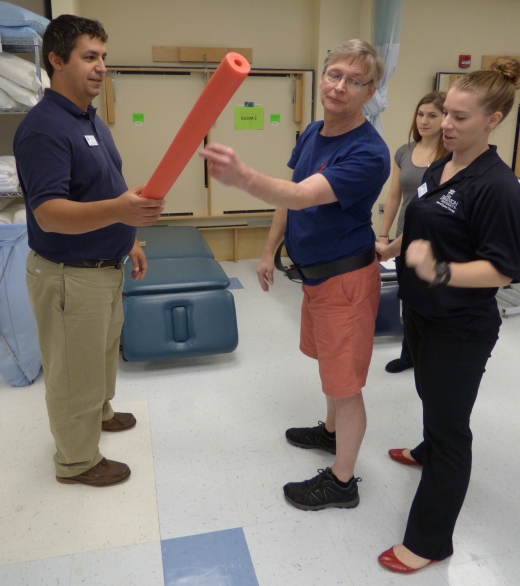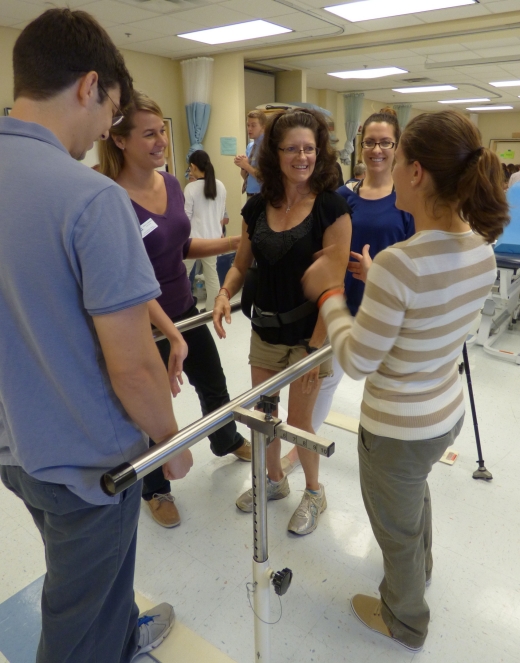Physical Therapy Students Work with Community Volunteers for Real-World Experience
November 12, 2015
 Physical therapy students Justyn Yager, Maggie Gamer and Meredith Tice work with stroke patient James Craft.
Physical therapy students Justyn Yager, Maggie Gamer and Meredith Tice work with stroke patient James Craft.
 Physical therapy students Will Adams, Kelsey Littlefield, Jenn Waidelich and Kaitlyn Helsley assist Terry Cook, who has multiple sclerosis.
Physical therapy students Will Adams, Kelsey Littlefield, Jenn Waidelich and Kaitlyn Helsley assist Terry Cook, who has multiple sclerosis.
Crippling mobility issues can spring up without notice. Just ask Old Dominion physical therapy lab volunteer James Craft.
The Chesapeake resident says he had a hidden birth defect that didn't surface until he was 47 years old. That's when he was diagnosed with arteriovenous malformation, or AVM. In Craft's case, the condition consists of a snarled tangle of arteries and veins in his brain.
AVMs, which occurs in less than 1 percent of the general population, can be devastating and even fatal. They can cause intracranial bleeding; seizures; extreme head pain; stroke; and difficulty with speech, movement and vision. Craft suffered a stroke in 2005 and also had a severe brain hemorrhage.
As a result of AVM, Craft underwent, brain surgery, and said he was told "I'd probably never walk again." Not one to take that prognosis sitting, Craft has been coming to Old Dominion University since 2009 - and working on his walking.
Every fall, since 2005, ODU's Doctor of Physical Therapy students have worked with volunteer patients like Craft as part of a special program that combines community outreach and real-patient experience.
The program - started by senior lecturers Mira Mariano and Beth Jamali - pairs groups of students with local residents who have neurological conditions, such as brain injuries, multiple sclerosis, Parkinson's disease, stroke and other conditions that affect mobility, balance and function. Volunteers come to the Program in Physical Therapy's lab, where they are evaluated by students under the close supervision of PT faculty. The students practice their evaluation techniques with clients and then work with them to devise interventions for mobility problems.
"All ... students participate in four sessions as a part of their coursework," Mariano said. "We use between 12 and 15 volunteers for the first three sessions and then about 25 to 30 clients for the last session, which comprises the students' final neurological practical exam."
The volunteers, many of whom return annually to the program, are no strangers to working with students and are quick to critique any situations where they believe care could have been better. They also have formed lasting bonds among themselves while participating in the program.
"The students give me a chance to remember the correct ways to repair my stride and gait," said Craft, a former parts manager for a tractor dealership.
Craft said he learned about the program when Mariano and Jamali came to a stroke support group at the Chesapeake Regional Medical Center, where both are employed.
The use of neurological community volunteers is a break from the Program in Physical Therapy's traditional use of standardized patients, who are actors used in educational settings for many health care students.
"We used to use standardized patients ... for the practical examinations but it is really difficult for them to portray consistent neurological signs and symptoms reliably," Mariano said. "We are both still active in clinical practice so we thought we would ask our former patients if they wanted to come in and volunteer their time working with our students."
And it worked.
The two faculty members started with a handful of volunteers and they now have a database of about 45 to 50 clients who come in for up to four lab sessions each fall. They also have added volunteers by seeking referrals from local clinics where they have relationships.
The use of neurological clients has been a multiple-win situation, Mariano said. It has provided a practical experience for the students, free assistance for those in the community and an opportunity for both faculty and volunteers to teach.
"In a way, the volunteers 'teach' our students about some things that cannot be learned through didactic teaching," Mariano said. "Things like being patient when a person has difficulty speaking after a stroke; being empathetic when someone talks about how they were not able to return to work after their head injury; and being a coach to when a patient thinks they cannot do something.
"These qualities are discussed but are difficult for students to exhibit on their own classmates in role-play lab practice and are often not developed yet in physical therapy students while still in training," she said.
Mariano added that many of the sites in the school's clinical rotation comment on how her students "hit the ground running."
"I really feel like these experiences help to facilitate that," she said.
For Craft, who turned 58 this year, the program has been a godsend, providing him with an annual cost-free source of rehabilitation.
"It has been a beautiful opportunity," he said.

